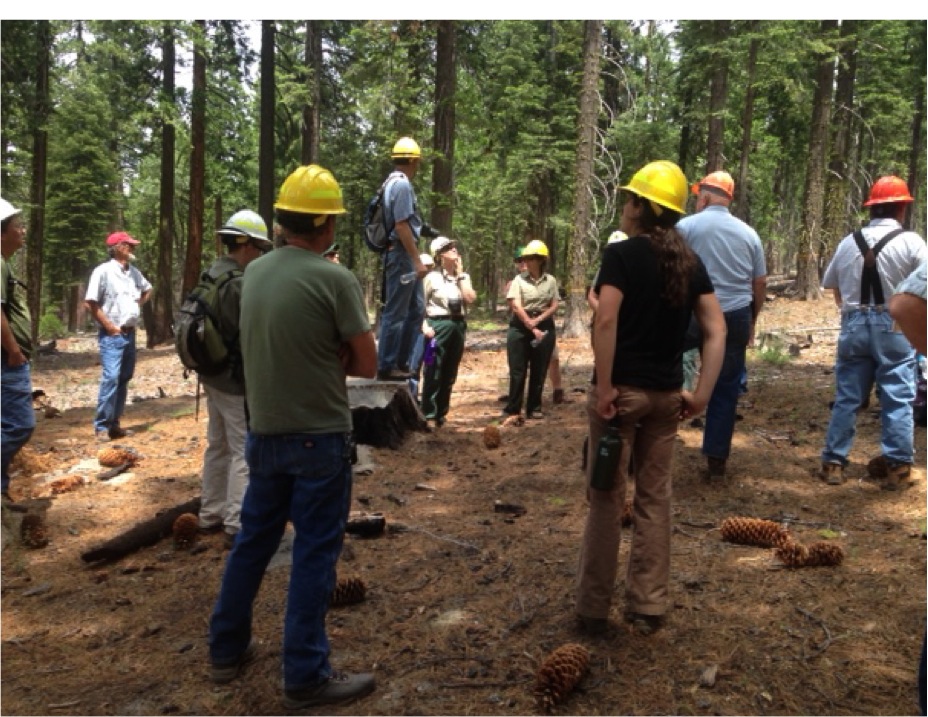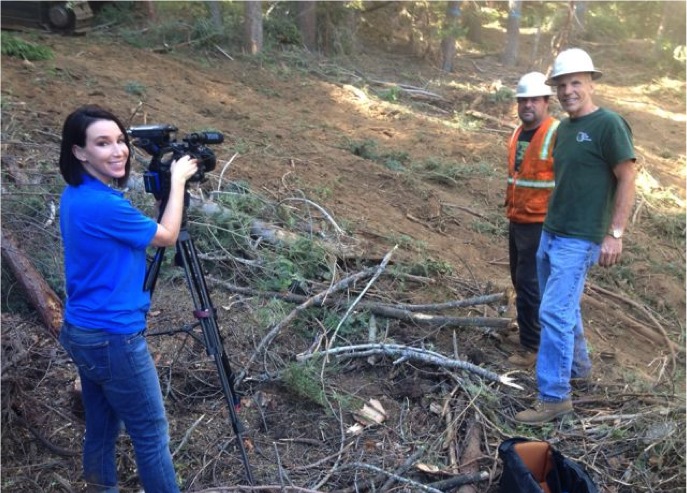 The casualness of the group at left doesn’t reflect the intensity of the topic of their field session. “How can forest management reduce the risk of devastating mega-fires such as the Rim Fire?” USFS staff and members of the Yosemite Stanislaus Solutions (YSS) collaborative group are gathered around Dr. Eric Knapp and Dr. Malcom North as the two scientists explain research-based logging treatments that reduce the damage from severe wildfires, benefit shade-dependent wildlife, and also produce profitable wood products. A scientific concept paper (referred to as GTR-220) gained a lot of attention in recent years and served as the focus for this session. USFS research scientists went back to century-old reports that described plots and tree sampling studies from historic, unmanaged forests. They found that trees were far less dense, and forests had far more diversity than current conditions. Forests were also highly resistant to severe wildfires. Scientists recognized the need to mimic the random clumps, openings, and scattered park-like conditions that were documented in the studies. In Dr. Knapp’s study plots, foresters used logging to create spacing between individual trees to reduce fire risk, but shade-favoring firs were also left in clumps where moisture was adequate. Small ¼-acre openings were cleared in the treatment area so that more light reaches sun-dependent hardwoods and pines that benefit from removing dense conifers that can choke out oaks. The Experimental Forest field sessions were a result of CSERC’s director collaborating with Mike Albrecht of the local timber industry (below at right) to arrange the two events. The first session raised the understanding of local USFS staff and YSS members. A second similar science training session was then put on for county supervisors, staff from various politicians’ offices, and the media. Both events emphasized that doing more prescribed burning is an essential tool that needs to be used along with the science-based logging treatments. The need to raise awareness about balanced solutions to drought-stressed, overly dense forests is a key reason that CSERC is actively promoting both science-based treatment methods – variable thinning logging as well as the broader use of prescribed burning. Without more treatments to deal with decades of fuel accumulation, the massive Rim Fire could become just one of countless new high severity fires where prime, mature forest habitat is damaged. CSERC aims to use TV, radio, newspapers, and collaboration to increase public support for doing more to restore natural forests and to hopefully prevent giant, high severity “burn-scapes.”
The casualness of the group at left doesn’t reflect the intensity of the topic of their field session. “How can forest management reduce the risk of devastating mega-fires such as the Rim Fire?” USFS staff and members of the Yosemite Stanislaus Solutions (YSS) collaborative group are gathered around Dr. Eric Knapp and Dr. Malcom North as the two scientists explain research-based logging treatments that reduce the damage from severe wildfires, benefit shade-dependent wildlife, and also produce profitable wood products. A scientific concept paper (referred to as GTR-220) gained a lot of attention in recent years and served as the focus for this session. USFS research scientists went back to century-old reports that described plots and tree sampling studies from historic, unmanaged forests. They found that trees were far less dense, and forests had far more diversity than current conditions. Forests were also highly resistant to severe wildfires. Scientists recognized the need to mimic the random clumps, openings, and scattered park-like conditions that were documented in the studies. In Dr. Knapp’s study plots, foresters used logging to create spacing between individual trees to reduce fire risk, but shade-favoring firs were also left in clumps where moisture was adequate. Small ¼-acre openings were cleared in the treatment area so that more light reaches sun-dependent hardwoods and pines that benefit from removing dense conifers that can choke out oaks. The Experimental Forest field sessions were a result of CSERC’s director collaborating with Mike Albrecht of the local timber industry (below at right) to arrange the two events. The first session raised the understanding of local USFS staff and YSS members. A second similar science training session was then put on for county supervisors, staff from various politicians’ offices, and the media. Both events emphasized that doing more prescribed burning is an essential tool that needs to be used along with the science-based logging treatments. The need to raise awareness about balanced solutions to drought-stressed, overly dense forests is a key reason that CSERC is actively promoting both science-based treatment methods – variable thinning logging as well as the broader use of prescribed burning. Without more treatments to deal with decades of fuel accumulation, the massive Rim Fire could become just one of countless new high severity fires where prime, mature forest habitat is damaged. CSERC aims to use TV, radio, newspapers, and collaboration to increase public support for doing more to restore natural forests and to hopefully prevent giant, high severity “burn-scapes.”

